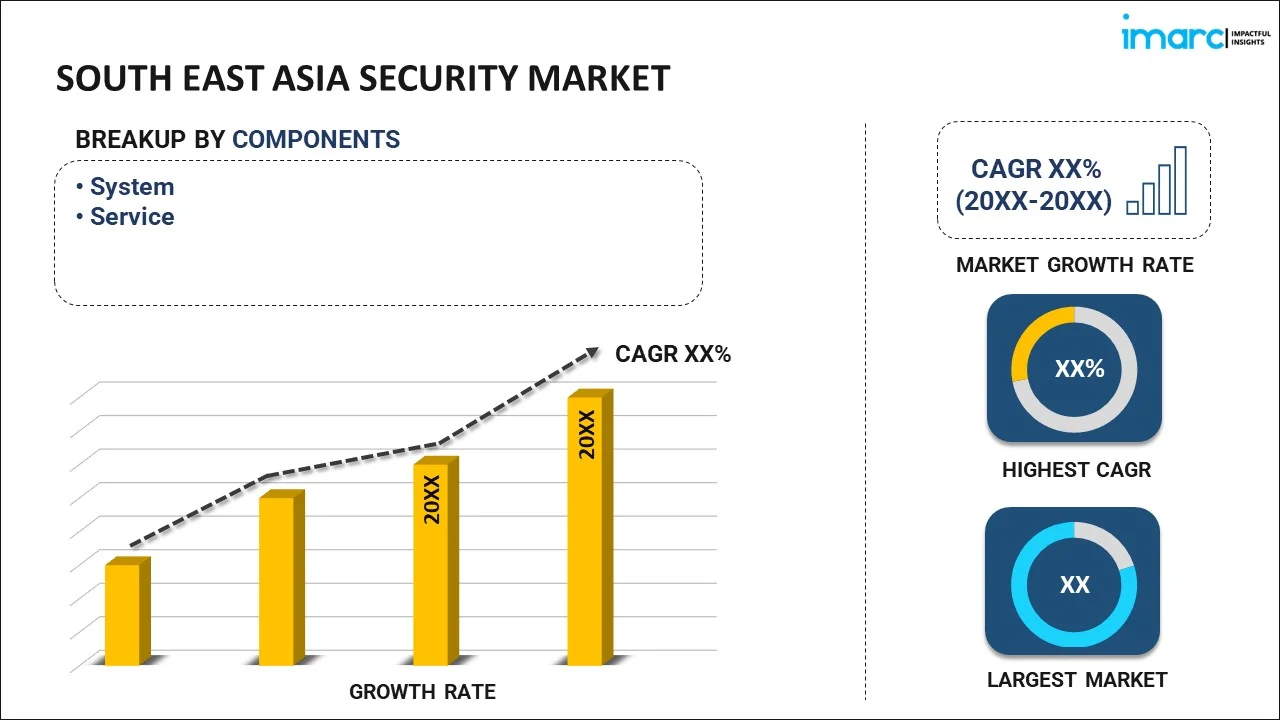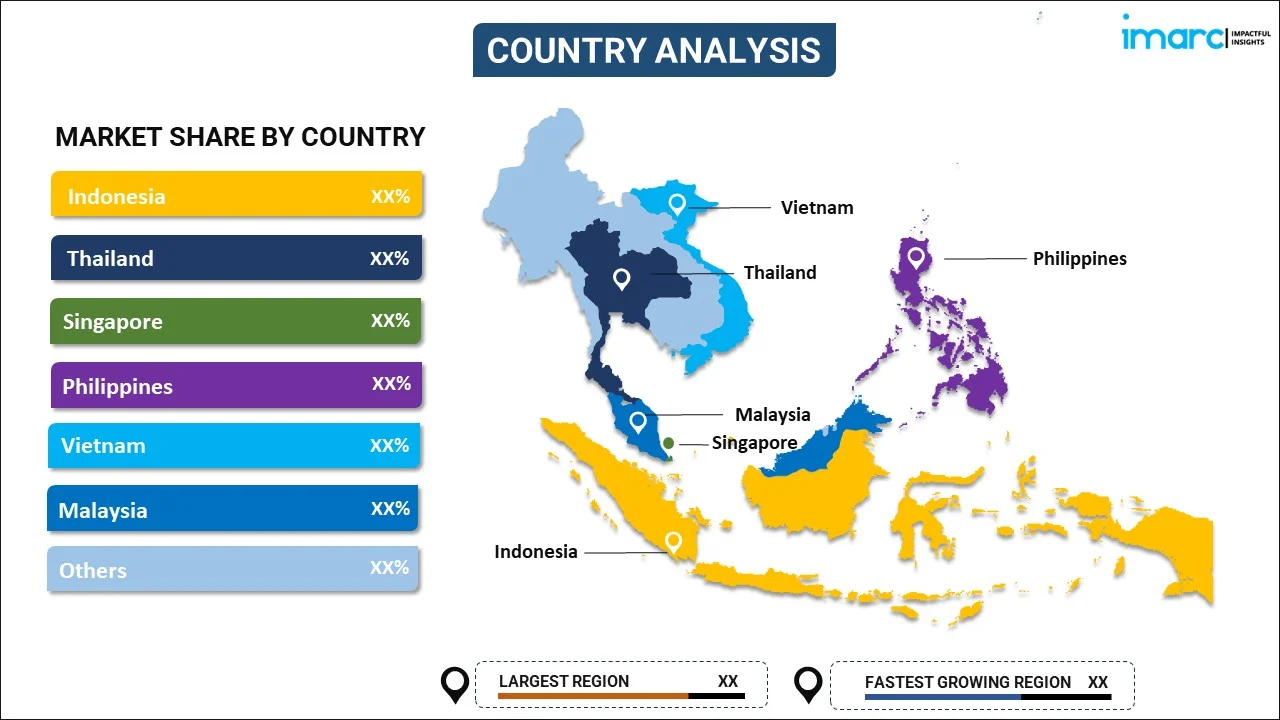
South East Asia Security Market Report by Component (System, Service), End User (Government, Military and Defense, Transportation, Commercial, Industrial, and Others), and Country 2024-2032
Market Overview:
South East Asia security market size is projected to exhibit a growth rate (CAGR) of 13.60% during 2024-2032. The increasing prevalence of cyber threats, including hacking, data breaches, and other cyber-attacks, which necessitates the development and adoption of robust security solutions, is driving the market.
|
Report Attribute
|
Key Statistics
|
|---|---|
|
Base Year
|
2023 |
|
Forecast Years
|
2024-2032
|
|
Historical Years
|
2018-2023
|
| Market Growth Rate (2024-2032) | 13.60% |
Security refers to the state of being free from danger or threat. It encompasses various dimensions, including physical, financial, and digital safety. In the context of physical security, it involves safeguarding individuals, assets, and properties from potential harm, theft, or unauthorized access. Financial security pertains to the stability and protection of one's monetary resources, ensuring financial well-being and resilience against economic uncertainties. Digital security focuses on protecting digital data and information from unauthorized access, use, or manipulation, thereby safeguarding privacy and preventing cyber threats such as hacking, data breaches, and malware attacks. Comprehensive security measures often involve the implementation of protocols, technologies, and strategies to mitigate risks, ensure confidentiality, integrity, and availability of resources, and create a sense of safety and trust within various domains and environments.
South East Asia Security Market Trends:
The security market in South East Asia is influenced by a myriad of factors, primarily due to the ever-evolving landscape of technology and dynamics. Firstly, the increasing prevalence of cyber threats has spurred a growing demand for sophisticated security solutions. Consequently, this has led to a surge in investments in innovative technologies, thereby propelling the security market forward. Additionally, the rising adoption of cloud computing and the Internet of Things (IoT) has significantly widened the attack surface, necessitating the deployment of robust security measures, thus serving as a major driver for the security market. Moreover, the escalating frequency and sophistication of cyber-attacks have prompted stringent regulatory frameworks, compelling organizations to allocate substantial resources toward compliance and security adherence. Consequently, this regulatory environment has become a crucial driver in shaping the security market landscape. Furthermore, the growing digitalization across industries, coupled with the expansion of e-commerce and online transactions, has amplified the need for secure payment gateways and data protection, fostering the continuous growth of the security market. As a result, these interconnected drivers continue to steer the security market in South East Asia towards innovation and resilience.
South East Asia Security Market Segmentation:
IMARC Group provides an analysis of the key trends in each segment of the market, along with forecasts at the regional and country levels for 2024-2032. Our report has categorized the market based on component and end user.
Component Insights:

- System
- Access Control Systems
- Alarms and Notification Systems
- Intrusion Detection Systems
- Video Surveillance Systems
- Barrier Systems
- Others
- Service
- System Integration and Consulting
- Risk Assessment and Analysis
- Managed Services
- Maintenance and Support
The report has provided a detailed breakup and analysis of the market based on the Component. This includes system (access control systems, alarms and notification systems, intrusion detection systems, video surveillance systems, barrier systems, and others) and service (system integration and consulting, risk assessment and analysis, managed services, and maintenance and support).
End User Insights:
- Government
- Military and Defense
- Transportation
- Commercial
- Industrial
- Others
A detailed breakup and analysis of the market based on the end user have also been provided in the report. This includes government, military and defense, transportation, commercial, industrial, and others.
Country Insights:

- Indonesia
- Thailand
- Singapore
- Philippines
- Vietnam
- Malaysia
- Others
The report has also provided a comprehensive analysis of all the major regional markets, which include Indonesia, Thailand, Singapore, Philippines, Vietnam, Malaysia, and Others.
Competitive Landscape:
The market research report has also provided a comprehensive analysis of the competitive landscape in the market. Competitive analysis such as market structure, key player positioning, top winning strategies, competitive dashboard, and company evaluation quadrant has been covered in the report. Also, detailed profiles of all major companies have been provided.
South East Asia Security Market Report Coverage:
| Report Features | Details |
|---|---|
| Base Year of the Analysis | 2023 |
| Historical Period | 2018-2023 |
| Forecast Period | 2024-2032 |
| Units | US$ Billion |
| Scope of the Report | Exploration of Historical and Forecast Trends, Industry Catalysts and Challenges, Segment-Wise Historical and Predictive Market Assessment:
|
| Components Covered |
|
| End Users Covered | Government, Military and Defense, Transportation, Commercial, Industrial, Others |
| Countries Covered | Indonesia, Thailand, Singapore, Philippines, Vietnam, Malaysia, Others |
| Customization Scope | 10% Free Customization |
| Report Price and Purchase Option | Single User License: US$ 3699 Five User License: US$ 4699 Corporate License: US$ 5699 |
| Post-Sale Analyst Support | 10-12 Weeks |
| Delivery Format | PDF and Excel through Email (We can also provide the editable version of the report in PPT/Word format on special request) |
Key Questions Answered in This Report:
- How has the South East Asia security market performed so far and how will it perform in the coming years?
- What has been the impact of COVID-19 on the South East Asia security market?
- What is the breakup of the South East Asia security market on the basis of component?
- What is the breakup of the South East Asia security market on the basis of end user?
- What are the various stages in the value chain of the South East Asia security market?
- What are the key driving factors and challenges in the South East Asia security?
- What is the structure of the South East Asia security market and who are the key players?
- What is the degree of competition in the South East Asia security market?
Key Benefits for Stakeholders:
- IMARC’s industry report offers a comprehensive quantitative analysis of various market segments, historical and current market trends, market forecasts, and dynamics of the South East Asia security market from 2018-2032.
- The research report provides the latest information on the market drivers, challenges, and opportunities in the South East Asia security market.
- Porter's five forces analysis assist stakeholders in assessing the impact of new entrants, competitive rivalry, supplier power, buyer power, and the threat of substitution. It helps stakeholders to analyze the level of competition within the South East Asia security industry and its attractiveness.
- Competitive landscape allows stakeholders to understand their competitive environment and provides an insight into the current positions of key players in the market.
Need more help?
- Speak to our experienced analysts for insights on the current market scenarios.
- Include additional segments and countries to customize the report as per your requirement.
- Gain an unparalleled competitive advantage in your domain by understanding how to utilize the report and positively impacting your operations and revenue.
- For further assistance, please connect with our analysts.
 Inquire Before Buying
Inquire Before Buying
 Speak to an Analyst
Speak to an Analyst
 Request Brochure
Request Brochure
 Request Customization
Request Customization




.webp)




.webp)












